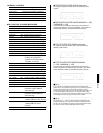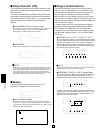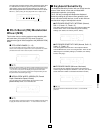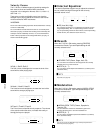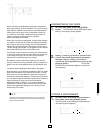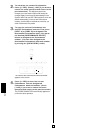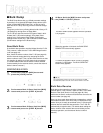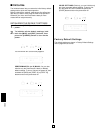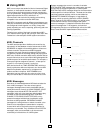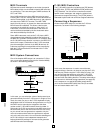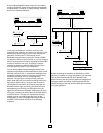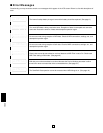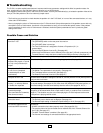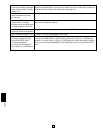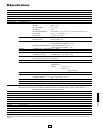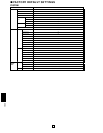
57
APPENDIX
System messages also come in a number of varieties.
SYSTEM REALTIME messages are used to start, stop and
synchronize the sequencing devices in a MIDI system.
SYSTEM EXCLUSIVE messages allows for the transmission
of data specific to individual devices. This data can be either
individual parameter settings, which are transmitted as
PARAMETER CHANGE messages, or large blocks of
settings, which are usually referred to as BULK DUMPS.
When using the P-150’s MIDI functions, you will be mainly
concerned with channel voice messages and system
exclusive messages. For detailed information about other
types of messages the P-150 supports, and how their
corresponding functions are implemented, refer to the MIDI
Data Format and MIDI Implementation Chart sections.
■ Using MIDI
MIDI is an acronym that stands for Musical Instrument Digital
Interface, an international standard in use since the 1980s
for the purpose of allowing electronic musical instruments—
such as synthesizers, tone generators, rhythm programmers,
digital keyboards like the P150, and others—to
“communicate” with each other by sending and receiving
compatible note, controller and other MIDI data.
With MIDI, instruments made by different manufacturers can
easily be connected to each other using special MIDI cables,
and configured to work together in a variety of ways that
greatly expands your music composing, performing and even
learning capabilities.
Following is an outline of the basic concepts about MIDI
you’ll need to know to get up and running in short order. Also
included are a few examples of MIDI system connections.
MIDI Channels
The MIDI standard provides 16 different channels for the
transmission of data between musical instruments. A MIDI
KEYBOARD is capable of transmitting data on at least one
of these channels. Sequencers and MIDI-equipped
computers with music sequencing software (both of which
are generally capable of recording, editing and playing back
MIDI note, controller and other data) usually transmit data on
several channels at once, each channel being designated for
a different part of an ensemble performance. For example, a
Piano part might be assigned to channel 1, a bass part to
channel 2, a horn part to channel 3, and so on.
MIDI devices known as TONE GENERATORS, which are
literally synthesizers without a keyboard, can receive MIDI
data from keyboards, sequencers, or computers and
produce sounds in response. MULTITIMBRAL tone
generators can play more than one voice at a time, since
they can receive data on more than one channel at a time.
MIDI Messages
Data which is transmitted between MIDI devices takes the
form of MIDI messages. There are various types of
messages. Messages most closely associated with the
actual performance of music are called CHANNEL VOICE
messages; these include NOTE ON and NOTE OFF
messages, which tell a tone generator which notes to play,
and when to start and stop playing them. CONTROL
CHANGE, PITCH BEND, and AFTERTOUCH or key
pressure messages indicate how a keyboard’s control
functions are being operated. PROGRAM CHANGE
messages tell a tone generator to switch to another voice.
Channel voice messages are transmitted on a specific
channel which will be received by the tone generator for
which they are intended. They are different from SYSTEM
messages, which are transmitted on all channels and
received by all of the devices in a MIDI system.
Channel
Messages
System
Messages
VOICE
MODE
Note On/Off, Control Change,
Program Change, Pitch Bend,
Channel Pressure*
All Note Off
REALTIME
Start*/Stop*/Continue*,
Active Sensing
End of Exclusive (F7)COMMON
EXCLUSIVE System Exclusive (F0)
*Transmit only.



